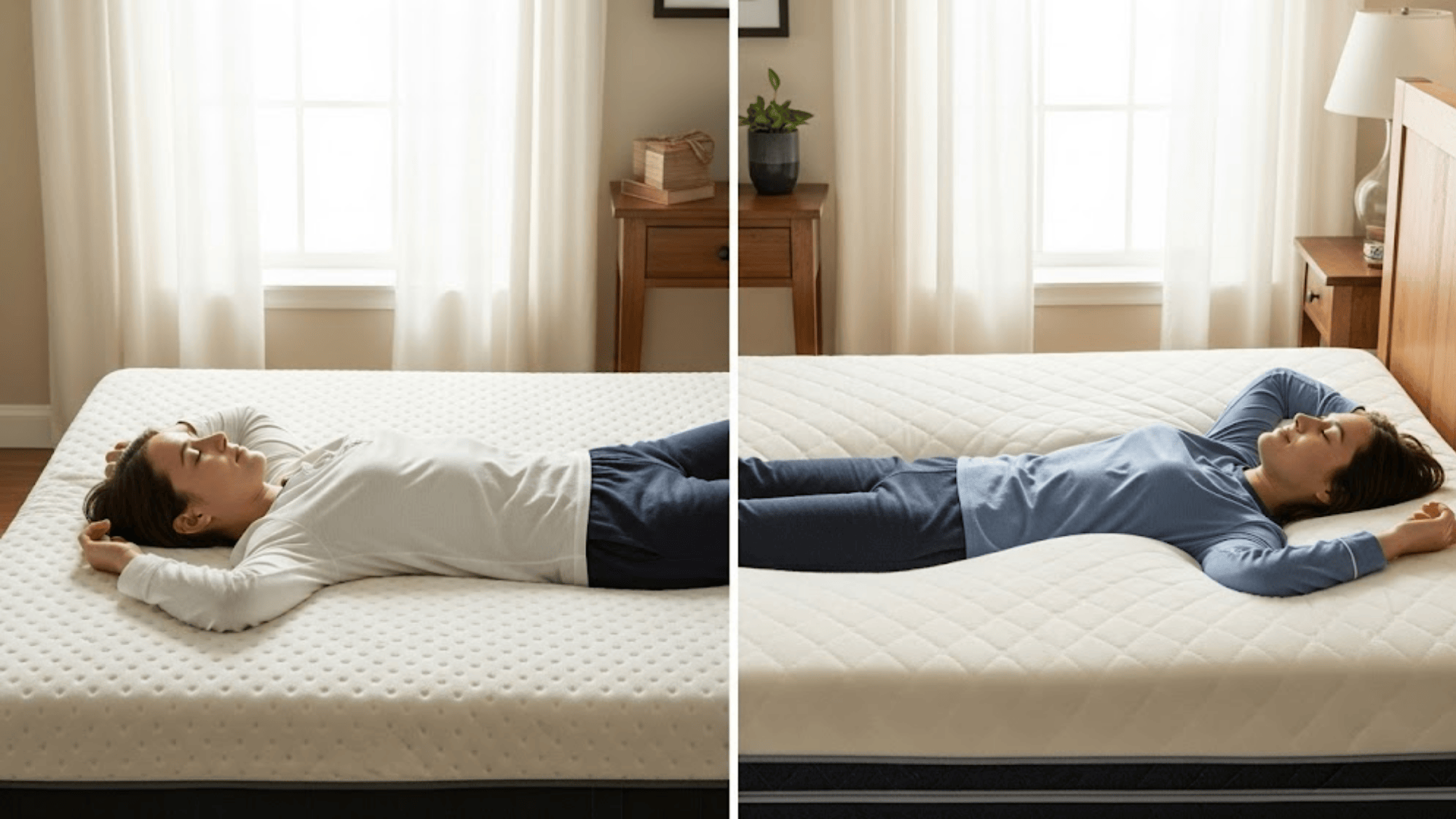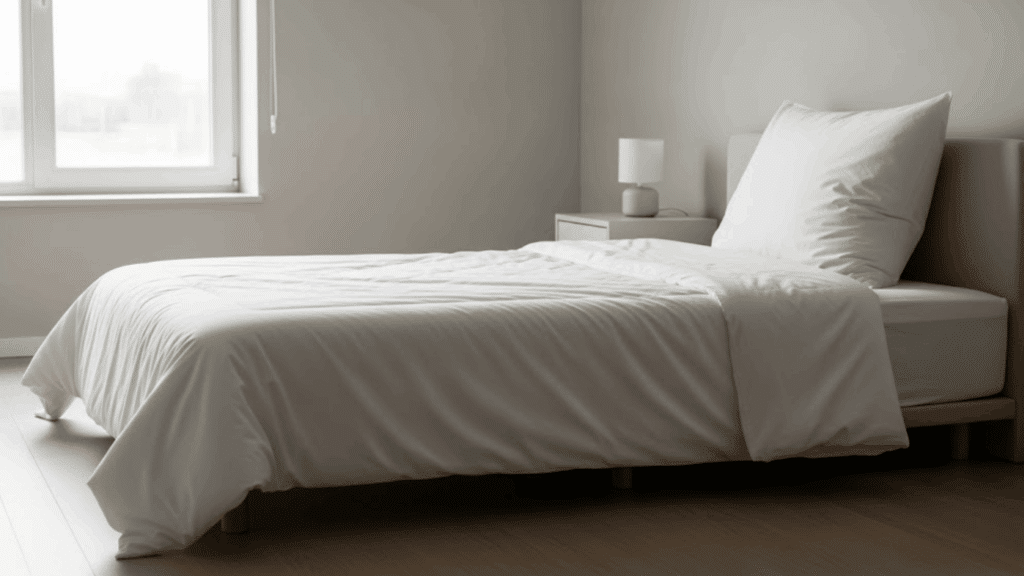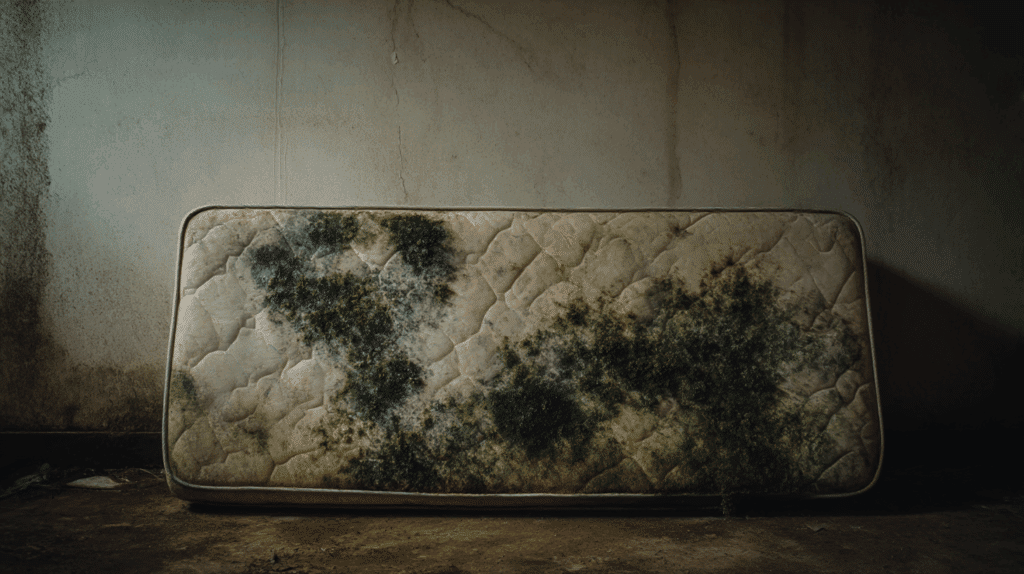Choosing the right mattress can feel a bit like dating; you’re searching for the one that understands your needs, supports you through tough nights, and won’t let you down after a few years.
Two of the most popular contenders in the mattress world are latex and memory foam, and while they may seem similar at first glance, they offer very different sleep experiences.
Memory foam is famous for its contouring hug that molds to your body, while latex is loved for its bouncy responsiveness and natural cooling.
Both have loyal fans and unique strengths, but the real question is: which one suits you best?
In this guide, we’ll break down latex mattress vs memory foam in terms of comfort, durability, and ideal sleeper types, so you can confidently choose a mattress that fits your lifestyle
Understanding Latex Foam vs Memory Foam
When shopping for a new mattress, the type of material inside can make all the difference between Latex Foam vs Memory Foam, waking up refreshed and tossing around all night.
While they might look similar from the outside, the way they feel, perform, and age over time is surprisingly different.
Latex foam is prized for its natural bounce, breathability, and eco-friendly properties. Made from either natural rubber tree sap, synthetic latex, or a blend of both.
It offers supportive cushioning without the sinking-in feeling. It’s naturally resistant to dust mites, mold, and bacteria, making it a great choice for allergy sufferers.
Memory foam, developed by NASA in the 1960s, is designed to contour perfectly to your body. Made from viscoelastic polyurethane, this product creates a signature hugging sensation.
This makes it a favorite for people needing targeted pressure relief, like side sleepers or those with joint pain.
How Do These Two Mattress Types Compare?

Now that you know what latex foam and memory foam are, it’s time to see how they actually perform where it matters most when you’re lying down and trying to get a good night’s sleep.
From how they feel the moment you settle in to how they handle movement, heat, and long-term use, each material has its own personality.
Comfort & Feel
When it comes to comfort, memory foam offers a deep, body-hugging sensation that cradles your curves and relieves pressure points. It’s especially loved by side sleepers and those with joint or back pain.
Latex foam, on the other hand, provides a buoyant, responsive feel. Instead of sinking in, you’ll feel gently lifted, making it easier to change positions, perfect for combination or stomach sleepers.
Motion Isolation
Memory foam excels at absorbing movement, meaning you’re less likely to be disturbed if your partner tosses and turns.
Latex foam is naturally springier, so it transfers slightly more motion, though high-quality latex still minimizes disruptions for most sleepers.
Temperature & Breathability
Latex foam naturally promotes airflow thanks to its open-cell structure, keeping you cool throughout the night.
Memory foam tends to trap more heat, but modern innovations like gel infusions and ventilated designs have improved its cooling performance.
Durability & Lifespan
Latex foam is known for its exceptional longevity, with natural latex mattresses lasting 15–25 years.
Memory foam typically lasts 8–12 years, depending on density and care, but high-quality models can perform well for longer with proper maintenance.
Pros and Cons of Latex And Memory Foam
Before making your choice, it helps to clearly see where each mattress material shines and where it falls short. Here’s a breakdown so you can quickly decide which one matches your sleep style, budget, and comfort needs.
Latex foam
| Pros | Cons |
|---|---|
| Naturally breathable and cool for hot sleepers | Higher upfront cost compared to many foam options |
| Bouncy, responsive feel that makes moving easier | Heavier and harder to move around |
| Extremely durable, often lasts 15–25 years | Less effective at isolating motion partner movements may be felt |
Memory Foam
| Pros | Cons |
|---|---|
| Exceptional contouring and pressure relief for joints | Can retain heat without cooling technology |
| Excellent motion isolation, great for couples | Slow response time may feel stuck in the mattress |
| Available in a wide range of price points | Shorter lifespan (8–12 years on average) compared to latex |
If you want a cool, responsive, and long-lasting mattress, latex is worth the investment. If you prefer a soft, contouring, and motion-free sleep, memory foam may be your perfect fit.
Finding Your Perfect Match
Choosing between latex and memory foam isn’t just about picking a mattress; it’s about finding the one that truly fits your sleep style.
If you’re the type who moves around a lot at night, prefers a bit of bounce, and sleeps hot, latex could be your dream partner.
Its responsiveness, breathability, and long lifespan make it a worthy investment for active or warm sleepers.
On the other hand, if you love the feeling of being cradled and need targeted pressure relief, memory foam might be your perfect fit.
It molds to your body, minimizes motion transfer, and offers plush comfort, making it great for side sleepers, couples, and anyone with joint pain.
Key Factors to Consider Before You Buy
When choosing between latex and memory foam, a side-by-side look at buying factors can make your decision much clearer. Here’s a quick guide to help you focus on what matters most.
| Factor | Latex Foam | Memory Foam |
|---|---|---|
| Firmness Options | Available in soft, medium, and firm Talalay for plush feel, Dunlop for firmer support | Wide variety from ultra-soft to extra-firm, ideal for customizing comfort |
| Cooling Features | Naturally breathable and cool without added tech | Look for gel-infused, copper-infused, or open-cell designs to avoid overheating |
| Motion Isolation | Moderate may feel partner movement | Excellent, ideal for couples and light sleepers |
| Durability | Extremely durable (15–25 years) | Moderate durability (8–12 years) is higher with dense foam |
| Allergy Resistance | Hypoallergenic, resistant to dust mites and mold (natural latex) | Not naturally hypoallergenic needs protective covers |
| Budget Range | Higher upfront cost, but long-term value | Wide range from budget-friendly to luxury models |
| Trial Period & Returns | Look for at least 90–120 nights | Look for at least 90–120 nights |
Tip: No matter which you choose, take advantage of trial periods and warranties to ensure your mattress feels right after several weeks of real-life use.
Keeping Your Mattress in Top Shape
Your mattress works hard every night, so giving it the right care will keep it comfortable, supportive, and hygienic for years to come. While latex and memory foam are both known for their durability, they each have unique needs when it comes to upkeep.
Latex Foam
Latex mattresses are built to last, but proper care will help them stay in top condition for decades. Always use a high-quality mattress protector to guard against spills, sweat, and dust.
Rotate the mattress every three to six months to ensure even wear, especially if you tend to sleep in the same spot each night.
Keep your latex mattress in a cool, well-ventilated room and avoid direct sunlight, as UV exposure can degrade natural latex over time.
Regularly vacuum the surface with a soft brush attachment to remove dust and allergens. Also, avoid bending or folding the mattress, as it can damage the latex’s supportive structure.
Memory Foam
Memory foam mattresses require a bit of extra care to maintain their contouring comfort.
Use a mattress protector to prevent stains and protect against moisture, which can damage the foam and encourage mold growth.
Keep it in a well-ventilated space to minimize heat and moisture buildup, ensuring it stays fresh and supportive for years.
Final Verdict: Which One Wins?
Choosing between latex and memory foam comes down to what matters most for your comfort, budget, and sleep style.
Latex offers a naturally cool, responsive feel with exceptional durability, making it ideal for hot sleepers, combination sleepers, and those looking for a long-term investment.
Memory foam, on the other hand, delivers unmatched contouring, pressure relief, and motion isolation, perfect for side sleepers, couples, and anyone wanting that hugged sensation.
Take your time, test different options if possible, and don’t overlook trial periods and warranties. After all, the right mattress isn’t just about better sleep tonight, it’s about waking up refreshed and pain-free for many mornings to come.
Which team are you on, latex or memory foam? Comment down below and share your pick!





